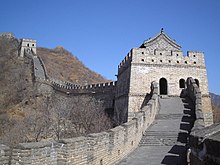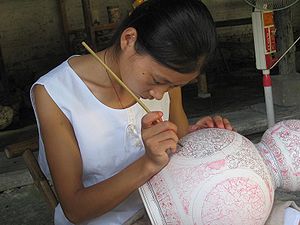There is an old saying in China, "
After you have come back from Huangshan, you won't look at other mountains anymore". Such was the high praise given to the beauty of Huangshan or the Yellow Mountain by the early travellers. What it means is that when you have seen Huangshan, you have seen the best.
Huangshan (
黄山 literally means "
Yellow Mountain"),
is a mountain range in southern Anhui province in eastern China. This mountain range is composed of material that was uplifted from an ancient sea over a 100 million years ago. The mountains themselves were carved by glaciers with trees growing at altitude above 1,800 meters (5,900 ft). The whole region of Huangshan is well known for its scenery, sunsets, granite peaks, pine trees, and views of the clouds from above. These are the four things visitors to Huangshan are looking for: the different shapes of granite peaks, the mysterious sea of clouds, the beautiful sunrises and the irregular pine trees. Huangshan is a frequent subject of traditional Chinese paintings and literature, as well as modern photography. It is a UNESCO World Heritage Site, and one of China's major tourist destinations.
The Huangshan mountain range has many peaks, some more than 1,000 meters (3,250 feet) high.
The three tallest and best-known peaks are
Lotus Peak (Lian Hua Feng, 1,864 m),
Bright Summit Peak (Guang Ming Ding, 1,840 m), and
Celestial Peak (Tian Du Feng, literally
Capital of Heaven Peak, 1,829 m).
This World Heritage Site covers a core area of 154 square kilometres and a buffer zone of 142 square kilometres.
 |
| The Welcome Pine |
A special pine trees, Huangshan pine, are unique as these trees thrive by growing straight out of the rocks. Many of these pine trees are more than a hundred years old and have been given their own names (such as the
Ying Ke Pine, or
Welcoming-Guests Pine, which is thought to be over 1500 years old).
The pines vary greatly in shape and size, with the most crooked of the trees being considered the most attractive. The mountaintops often offer views of the clouds from above, known as the
Sea of Clouds (
云海).
The area is also noted for producing light effects from the sun, such as the renowned sunrises viewed from the observation platform. Watching the sunrise is considered a major item of visitors' itinerary. In order not to miss the sunrise, visitors have to wake up at 4 am in the morning and make their way to a location specially designated for viewing sunrise in Huangshan. In addition, Huangshan has multiple hot springs, most of them located at the foot of the
Purple Cloud Peak. The water stays at 42 °C all year
and has a high concentration of carbonates, and is said to help prevent skin, joint, and nerve illness.
 |
| The many steps in the new route |
 |
| A cable car ride to hotel |
Our trip to Huangshan began at Guangzhou where we took a connecting flight to Anhui Province where Huangshan is located. After breakfast, we visited a local old village called Hongchun before setting foot to the Mountain. At the foot of the mountain, we were first treated with a cable car ride up the mountain. The scenery was beautiful and we could see the vast mountainous region of Huangshan. When we alighted from the cable car, we had to walk a one-hour journey (mainly steps and more steps around the mountain) to the hotel at Huangshan. By the time we reached the hotel, we were already dead tired, and the hiking in Huangshan had not even started. We could imagine the hardship and the uncertainty ahead of us. After we put down some light luggage in the hotel (where we stayed overnight), we started what seemed to be the longest hiking of our life, a 5-hour journey up and down the numerous steps of trekking in Huangshan. Set aside this hardship, we felt that the journey was worth it as the views of the majestic mountain ranges and the surroundings were spectacular. The pine trees of Huangshan were equally impressive, growing out of the rocks in diversified shapes and sizes. We live in a small country; as we were hiking, we could sense the sheer size of this region, the vastness, it is really awesome. One thing worth mentioning in this trip is this new route that was just created and opened to tourists recently. This is the route behind (the back) Huangshan where the steps were much easier (more gentle) to climb than the old route (the front side of Huangshan) where the steps were steep and dangerous. If you are adventurous, I recommend the front route as it is more challenging. But for senior citizens like us, we rather kept to the new route for safety reason.
 |
| Huangshan |
 |
| Huangshan pine |
 |
| The Sea of Clouds 云海 |
These never ending steps in Huangshan were interesting. In order to climb up the mountain, sometimes we had to climb down the mountain a few thousand steps before ascending again. That was sheer tiring, if you are not fit, better stay out. My travel mate told me that he had to take pain killers the night before the trip to the mountain. As it turned out, he was the last to complete the journey (exhausted and almost burnt out), with much cheering from the rest of the group. The new route actually brought us down to the bottom and the view of Huangshan from below was magnificent. But the time we reached the hotel, we were late for dinner. The next morning, some of us were able to get up at 4 am and went to the designated place to view the sunrise. Unfortunately, I missed this opportunity as I was too tired to wake up to watch this spectacular view of sunrise in Huangshan. Luckily I have a photo from my friend who had viewed the sunrise and it is here for sharing. However there is still one thing we did not accomplish in Huangshan. We were not lucky enough to see the sea of clouds
云海 at Huangshan as the sky at that time was very clear, not a trace of cloud. What a pity. I was told that some visitors even stay for a few days at Huangshan just to catch a glimpse of this spectacular view.
 |
| The sunrise at Huangshan |
 |
| Stunning View of Huangshan |
















 a vast black forest. These rock formations, caused by the dissolution of limestone, are believed to be over 270 million years old and are a tourist attraction for both overseas and local tourists. There are narrow and winding pathways that run between the rock formations, taking visitors to ever more unexpected and beautiful scenes. This region used to be an ocean. During the Long Geological Period from the late Permian Period 230 million years ago to 2 million years ago , the ocean subsided and giant rocks appeared. During this time the rocks were gradually worn away by water, forming the strange rock formations seem today. As soon as we entered the Stone Forest scenic area, a crystal-clear lake comes into focus. By the east side of the lake, a good array of fantastic stone pinnacles, pillars, shoots, and stalactites rise from the water , resembling a natural potted scenery.
a vast black forest. These rock formations, caused by the dissolution of limestone, are believed to be over 270 million years old and are a tourist attraction for both overseas and local tourists. There are narrow and winding pathways that run between the rock formations, taking visitors to ever more unexpected and beautiful scenes. This region used to be an ocean. During the Long Geological Period from the late Permian Period 230 million years ago to 2 million years ago , the ocean subsided and giant rocks appeared. During this time the rocks were gradually worn away by water, forming the strange rock formations seem today. As soon as we entered the Stone Forest scenic area, a crystal-clear lake comes into focus. By the east side of the lake, a good array of fantastic stone pinnacles, pillars, shoots, and stalactites rise from the water , resembling a natural potted scenery.









































